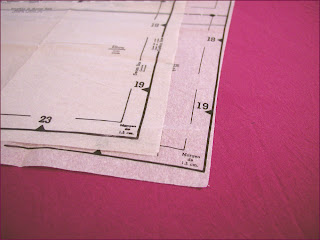I like to wonder how the pieces for that 32 bust would look as a 40 bust. The scale of size, what section was enlarged, etc. It just makes my brain go all crazy and makes me wonder what the pattern makers were thinking when they graded the patterns.
Then I came across this pattern. The same pattern at the very ends of the size spectrum. A 32 bust and a 52 bust. 20 inches of difference. Spectacular.
The patterns were both in their factory folds, but that didn't stop me. I'd never been able to compare two patterns like this, so I took out and unfolded the sleeve, bodice and facings just to see.
This all fascinated me. It also made me think of college and the perspective classes I took. In two point perspective, you'd draw a line to a vanishing point from an anchor point and between those two points you could map the size of pretty much anything. I thought of that when I was looking at these patterns.
With these two patterns acting as my points I could take any of the sizes in between simply by halving the distance of all the points between the sizes of each piece. Didn't matter where I placed the smaller piece on top of the larger one, it would always equal out. The perspective geek in me freaked out, and although I didn't do it, I totally was tempted.
It's the small things that make me happy :)









Wow. That was so cool. My mother was an undaunted seamstress. She could make a pattern bigger or smaller BUT she HAD to have a pattern. In my hippie days when sewing projects were taken from people telling me what to do (halter tops and skirts made from jeans) she'd just shake her head. Patterns intimidate me and looking at those and your explanation didn't help - but I liked seeing it.
ReplyDeleteWow - the opportunity here is amazing. Who'd think you'd be able to find the same two patterns in that sizing? Awesome.
ReplyDeleteWorking with modern multisize patterns taught me a lot about how a pattern should be graded, which helped a lot in my grading class at school - we had to do these horrible tedious grading projects, but I was able to spot if something looked off. But I loved my grading class - it opened up so many more options to me for working with vintage patterns!
ReplyDeleteRTW companies agonize how to accomodate all their customers with their grade rules, but pattern companies keep straightforward rules - sizes are just graded in even increments. Once the rules are set, it's all just a mathematical formula - thank goodness it doesn't have to be figured out from scratch each time! :)
Great info, Beth. I know nothing about the science of grading since Im not the text book size. I just never put any stock into industry sizing.
ReplyDeleteI think I'd love to learn it one day. :)
A couple tidbits you might find interesting - the base size is not the smallest size in your size range (as most people expect), but is in the middle. Then the smaller and larger sizes are graded out from the mid-size.
ReplyDeleteAlso, different parts of the body grow at different rates - the waist might shrink 2" from Medium down to Small, but the neck doesn't shrink that much between sizes! The neck probably only shrinks 1/8" or 1/4". That's why you get the funny perspective. That picture of the sleeve is a good example - the arm only gets a little *longer*, but gets much larger *around*.
And like you mentioned, you can't grade up and down indefinitely, because body shapes change when you get into the wee or the large. Kids clothes, Juniors, and Misses are all fit and graded differently because of that.
I've got a couple books on grading that are good - a little technical, but once you get the basics they're not difficult. If you ever want the titles, let me know. :)
Thanks Beth! From what you described, I totally understood! I can relate a lot of this to animation, and inbetweening. You can only do so much, and some movements are smaller and require less space than others.
ReplyDeleteWell, not that much difference conceptually after all!
When you described the median size, I guess thats why some clothiers use a plus size model as their median instead of a straight and grade from that, right? I think its all so very interesting.
That's really interesting Beth. I'd like to know the titles of the grading books please.
ReplyDelete